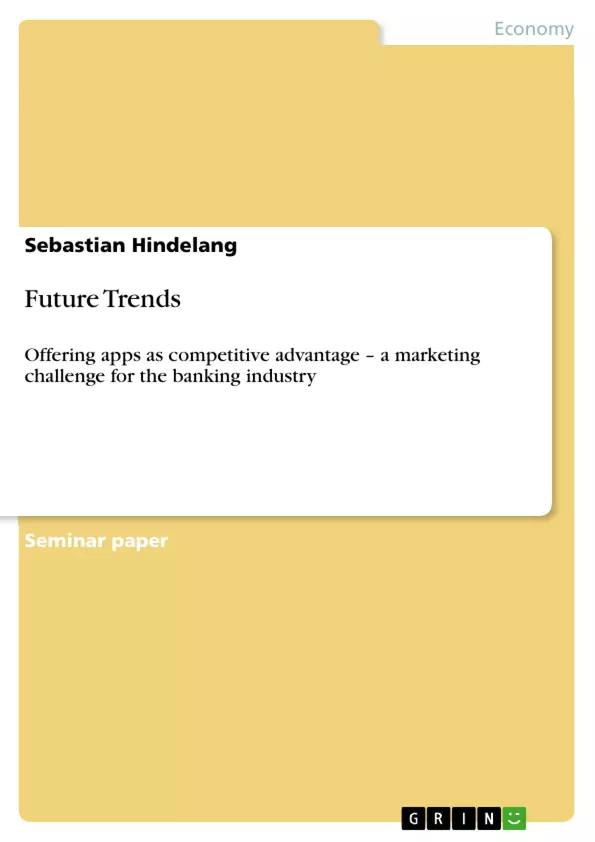The changing environment, the massive increase in competition and performance pressures force banks to find new ways to differentiate from competitors. At the same time the utilization of smartphones and mobile internet increased in the last few years. Would a bank get a competitive advantage, if it would offer applications (apps) for its services and products?
Since the launch of the iPhone in 2007 the mobile phone market has been undergoing a change and a new market segment of smartphones has been created. The market share of smartphones e.g. has increased up to 37.6% in Spain. The numbers of mobile internet users has been strongly rising at the same time. The growth rate reminds of the growth rates in the early days of the internet. Compared to the ‘for free’ culture in the internet, smartphone users are willing more likely to pay a fee for content or service.
Smartphones not only provide traditional telecommunication services, but also short message services, browser and application based services and near-field communication.
In order to survive in the competition, banks either have to focus on a strong differentiation or cost leadership. Established banks are unlikely to compete against low-cost banks, so they need to be clearly different from their competitors. They have to consider that their services are oriented on the customer needs. Therefore all banking services have to be aligned with the customer processes. A customer process is characterized as the entire end-to-end process a customer passes through to meet a desired need or to solve a problem until satisfaction is met. During each step of this process, the customer needs support from different suppliers to fulfil all needs of this process. A single process owner does not exist. Instead of this the customer has to get in touch with many different suppliers. Here the bank can act as service integrator to bundle the different interactions. The bank can demonstrate itself as primary contact to the customer via its multiple distribution channels. An app would act as primary communication channel as it becomes the constant companion of the client.
Inhaltsverzeichnis (Table of Contents)
- Introduction
- Market development
- Technical opportunities of smartphones
- Customer process integration
- Private clients
- Corporate clients
- Challenges to overcome
- Conclusion
Zielsetzung und Themenschwerpunkte (Objectives and Key Themes)
This assignment examines the potential for banks to utilize mobile applications (apps) to achieve a competitive advantage in a rapidly changing market landscape. The paper explores the opportunities presented by the rise of smartphones and mobile internet access for banks to differentiate their services and enhance customer experience.
- The impact of smartphone adoption and mobile internet growth on the banking industry
- The potential of apps to improve customer process integration and enhance user experience
- The challenges and considerations associated with implementing banking apps, including security and user identification
- The role of apps in offering both bank-specific products and services as well as acting as a broker for other providers
- The strategic advantages of being a first mover in the banking app market
Zusammenfassung der Kapitel (Chapter Summaries)
- Introduction: This chapter sets the stage for the discussion by outlining the competitive pressures facing the banking industry and the need for innovation to differentiate services. The chapter introduces the concept of mobile applications (apps) as a potential source of competitive advantage.
- Market development: This chapter explores the rapid growth of the smartphone market and mobile internet usage. It highlights the changing consumer behavior associated with smartphones and the increased willingness of users to pay for content and services.
- Technical opportunities of smartphones: This chapter delves into the technical capabilities of smartphones, including their potential for communication, data access, and location-based services. It outlines the opportunities for banks to leverage these capabilities in their app offerings.
- Customer process integration: This chapter examines how apps can be used to integrate customer processes within the banking sector. It explores the specific application of apps to private and corporate clients, highlighting the potential benefits for both customer segments.
- Challenges to overcome: This chapter addresses the challenges that banks face in implementing mobile apps, including security concerns and user identification. It discusses strategies for mitigating these challenges and ensuring the success of banking apps.
Schlüsselwörter (Keywords)
The main focus of this assignment is on the utilization of mobile applications, specifically apps, as a competitive advantage for banks. The paper explores the changing market environment, driven by the rapid adoption of smartphones and mobile internet access. Key themes include customer process integration, security concerns, user identification, and the potential for both bank-specific offerings and acting as a broker for other service providers. The potential benefits of being a first mover in this market are also discussed.
- Quote paper
- Sebastian Hindelang (Author), 2011, Future Trends, Munich, GRIN Verlag, https://www.grin.com/document/208487



